The Stability Cone for a Matrix Delay Difference Equation
Abstract
We construct a stability cone, which allows us to analyze the stability of the matrix delay difference equation xn = Axn−1 + Bxn−k. We assume that A and B are m × m simultaneously triangularizable matrices. We construct m points in ℝ3 which are functions of eigenvalues of matrices A, B such that the equation is asymptotically stable if and only if all the points lie inside the stability cone.
1. Introduction
Parameters of linear systems are subject to time changes. That is why in order to construct such systems it is desirable to know if they are not only stable but also able to estimate the distance of the system from the boundary of the stability region in the parameter space. Therefore, it makes sense to investigate the geometry of the subset of stable polynomials in the space of characteristic polynomials of linear systems (in the canonical space [1]). This idea has already been applied to the investigation of geometry of the subset of stable polynomials in a two-dimensional subspace of the canonical space [2, 3], the stability simplex for general difference equations [4], connections of the convexity of the coefficients sequence with stability of difference equations [5], and stability ovals for matrix difference equations of the form xn = xn−1 + Bxn−k with the delay k [6].
The paper is organized as follows. In the second section, we recall the results on the stability of the scalar equation (1.2) with real nonnegative a and any real b [14, 15]. Further in that section we construct the stability oval for (1.2) with real nonnegative coefficient a and complex coefficient b. In Section 3, we consider a wider class of equations of the form (1.2) with a, b being complex numbers. In Section 4, we state a system of inequalities allowing us to check the stability of the scalar equation (1.2) with two complex coefficients. In Section 5, we give a geometrical criterion for the asymptotic stability of matrix equation (1.1) with simultaneously triangularizable matrices. Besides, we establish nongeometric necessary and sufficient conditions for the stability of matrix equation (1.1) in terms of inequalities. In Section 6, we use the stability ovals and cones for analysis of some numerical examples.
2. The Stability Oval for (1.2) with Real Nonnegative a and Complex b
We start by stating the results from [14, 15] in the form which is suitable for us. Since the case k = 1 is obvious, we consider only the case k > 1.
Theorem 2.1 (see [14], [15].)In (1.2) let a and b be real, a⩾0, k > 1.
- (1)
If a⩾k/(k − 1), then (1.2) is unstable.
- (2)
If 0 ⩽ a < k/(k − 1), then (1.2) is asymptotically stable if and only if
(2.1)where ω1 ∈ [0, π/k] is the root of the equation
Stability region of (1.2) is shown in Figure 1.
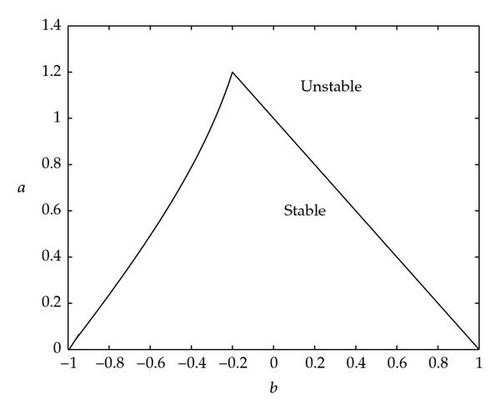
Our first new result about the case of nonnegative real a and complex b in (1.2) is the following.
Theorem 2.2. Let a⩾0 be a real number and b a complex number, k > 1.
- (1)
If a⩾k/(k − 1), then (1.2) is unstable.
- (2)
If 0 ⩽ a < k/(k − 1), then (1.2) is asymptotically stable if and only if b lies inside the oval bounded by
(2.3)where ω1 ∈ [0, π/k] is the root of (2.2). - (3)
If 0 ⩽ a < k/(k − 1) and b is outside of the stability oval (2.3), then (1.2) is unstable.
- (4)
If 0 ⩽ a < k/(k − 1) and b lies on the boundary (2.3) of the stability oval, then (1.2) is stable (nonasymptotically).
Proof. We will use the D-decomposition method (parameter plane method) [16, 17]. A characteristic polynomial for (1.2) is the following:
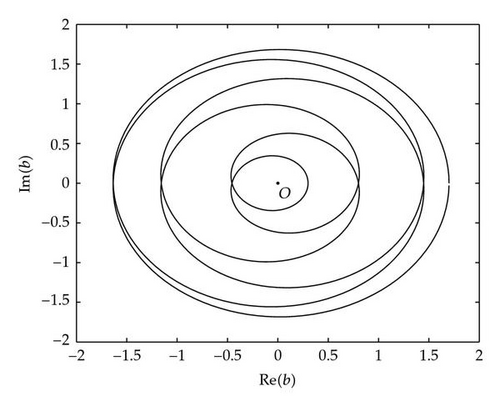
Example 2.3. Let k = 6 and, also, (1) a = 0.2, (2) a = 0.75, and (3) a = 1.1. Let b = 0.33 exp (iα), 0 ⩽ α < 2π. Let us analyze the asymptotic behavior of the solutions of (1.2) for all values of α. We construct three stability ovals for three values of a and also the circle b = 0.33exp (iα) (Figure 3). Theorem 2.2 and Figure 3 give the following result. (1) For a = 0.2, the equation is asymptotically stable for any value of α. (2) For a = 0.75, the equation is asymptotically stable for 2.0918≅α0 < α < 2π − α0≅4.1914, it is unstable for α ∉ [α0, 2π − α0], and it is stable (nonasymptotically) for α = α0 and α = 2π − α0. (3) Finally, for a = 1.1, the equation is unstable for any value of α.
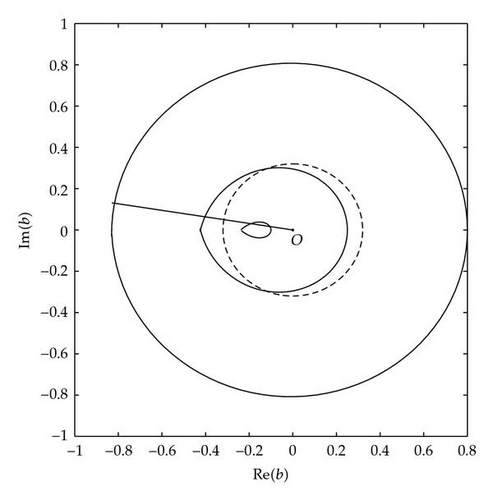
Example 2.4. Let k = 6 and, also, (1) a = 0.2, (2) a = 0.75, and (3) a = 1.1. Let b = rexp (i 19π/20), r⩾0. Let us find the asymptotic behavior of (1.2) for all values of r. We construct the beam b = rexp (i 19π/20) together with three stability ovals (Figure 3). Theorem 2.2 and Figure 3 give the following result.
- (1)
For a = 0.2, the equation is asymptotically stable for 0 ⩽ r < r1≅0.8276, it is unstable for r > r1, and it is stable (nonasymptotically) for r = r1.
- (2)
For a = 0.75, the equation is asymptotically stable for 0 ⩽ r < r2≅0.4080, it is unstable for r > r2, and it is stable (nonasymptotically) for r = r2.
- (3)
Finally, for a = 1.1, the equation is stable for 0.1063≅r31 < r < r32≅0.1944, it is unstable for r ∉ [r31, r32], and it is stable (nonasymptotically) for r = r31, r = r32.
3. The Stability Cone for (1.2) with Complex Coefficients
The family of stability ovals depending on a ∈ k/(k − 1) forms a surface which we call the stability cone.
Definition 3.1. The stability cone for delay k is a surface in a three-dimensional space (Re(b), Im (b), z) with 0 ⩽ z ⩽ k/(k − 1), such that its intersection with any plane z = a (0 ⩽ a ⩽ k/(k − 1)) is the stability oval (2.3).
The stability cone for k = 6 is presented in Figure 4.
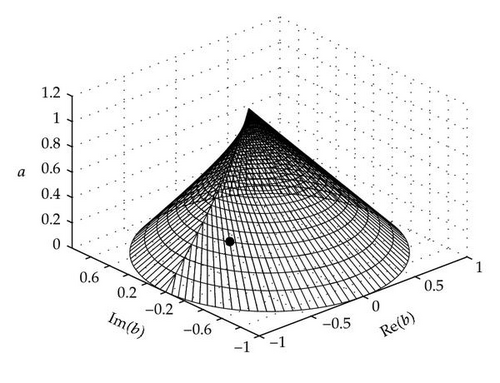
Theorem 3.2. Consider (3.3). Put
- (1)
Equation (3.3) is asymptotically stable if and only if the point M lies inside the cone (3.2) (if a = 0 and (Re(b)) 2 + (Im (b)) 2 < 1, then the point M is assumed to be the inner point of the cone).
- (2)
If the point M lies outside the cone (3.2) or on its top Re(b) = −1/(k − 1), Im (b) = 0, a = k/(k − 1), then (3.3) is unstable.
- (3)
If the point M lies on the boundary of a cone (3.2), but not on its top, then (3.3) is stable (nonasymptotically).
Example 3.3. Let us test the stability of the equation with complex coefficients
Example 3.4. We test (3.6) with a real parameter σ for stability. Unlike the previous example let now the delay be odd: k = 7. For positive σ by Theorem 3.2, according to (3.5) we obtain
Theorem 3.5. For even delays k the (asymptotic) stability of (1.1) implies the (asymptotic) stability of (3.12) and vice versa. For odd k the (asymptotic) stability of (1.1) implies the (asymptotic) stability of (3.13) and vice versa.
Similar properties of symmetry have been specified in [11, 15] for the scalar equation (1.2) with real a, b.
4. A System of Inequalities for Checking the Stability of (3.3)
In the previous sections we used some geometric procedures. In this section we construct a system of inequalities in order to check the stability of (3.3). Henceforth we assume 0 ⩽ arg(z) < 2π for a complex variable z.
Theorem 4.1.
- (1)
If ρ1 < 1 − ρ2, then (3.3) is asymptotically stable.
- (2)
If 1 − ρ2 ⩽ ρ1 < min(1 + ρ2, k/(k − 1)), then for the asymptotic stability of (3.3) it is necessary and sufficient to fulfill simultaneously the following conditions ((H1)), ((H2)):
( ( H 1 ) )where ω1 ∈ [0, π/k] is the root of the equation( ( H 2 ) ) - (3)
If ρ1⩾min (1 + ρ2, k/(k − 1)), then (3.3) is not asymptotically stable.
Proof. The stability of (3.3) is equivalent to the stability of (3.4), so we will work with (3.4).
- (1)
For ρ1 < 1 − ρ2 by Theorem 2.2 the stability oval exists and the circle of radius ρ2 lies completely inside the oval. Therefore, Theorem 2.2 implies the asymptotic stability of (3.4). Part 1 of Theorem is proved.
- (2)
Let 1 − ρ2 ⩽ ρ1 < min (1 + ρ2, k/(k − 1)). Let us consider two cases.
Case 1 ((1 − ρ2) ⩽ ρ1 < 1). In this case, the stability oval exists by Theorem 2.2, and the origin of the coordinates lies inside the oval. For (3.4) to be asymptotically stable, it is necessary and sufficient to satisfy the two following conditions. The first one is that the circle of radius ρ2 should intersect the stability oval. It is equivalent to ((H1)). The second condition is that the argument of a point exp (i(α2 − kα1)) should be between the arguments of the two crosspoints M1, M2 of a circle of radius ρ2 with the stability oval (2.3). Let us assume that Im (M1) > 0, and let the parameter ω correspond to the point M1. We obtain
Case 2 (1 ⩽ ρ1 < min(1 + ρ2, k/(k − 1))). By virtue of the inequality ρ1 < k/(k − 1), the stability oval exists, and, since ρ1⩾1, the origin does not lie inside the oval. The same requirements as in the previous case lead to the same conditions ((H1)), ((H2)). Part 2 of the Theorem is proved.
- (3)
Let ρ1⩾min (1 + ρ2, k/(k − 1)). We consider two cases.
Case 1 (1 + ρ2 ⩽ ρ1 < k/(k − 1)). In this case the stability oval exists by Theorem 2.2, and, by virtue of the inequality ρ1⩾1, the origin does not lie inside the oval. Due to the inequality ρ2 ⩽ ρ1 − 1, no point of the circle of radius ρ2 lies inside the oval and so (3.4) is not asymptotically stable by Theorem 2.2.
Theorem 4.1 is proved.
As we see, the text of Theorem 4.1 does not contain any geometric terms. However, Theorem 3.2 has a considerable advantage over Theorem 4.1 because of its simplicity and geometric visualization. That is why in the future examples we prefer describing the stability of matrix equation (1.1) in geometric terms.
5. The Stability Cone for the Matrix Equation with Simultaneously Triangularizable Matrices
In this section we consider (1.1) with simultaneously triangularizable matrices A, B.
Theorem 5.1. Let A, B, S ∈ ℝm×m and S−1AS = AT and S−1BS = BT, where AT, BT are the lower triangular matrices with elements, respectively, λjs, μjs(1 ⩽ j, s ⩽ m). Let
If for some j (1 ⩽ j ⩽ m) the point Mj lies outside cone (3.2), then (1.1) is unstable.
Proof. In (1.1) we substitute xn = Syn and multiply the equation by S−1. We obtain
Let us assume that some point (5.2) does not lie strictly inside the cone. Then, for the initial data in (5.4), we assume that for any s, n, such that 1 ⩽ s ⩽ j, 1 ⩽ n ⩽ k. Thus, (5.4) becomes (5.6). If the point (5.2) lies on the cone boundary, then (5.6) has a trajectory which does not tend to zero because the characteristic polynomial of (5.6) has a root z such that |z | = 1. If some point (5.2) lies outside the cone, then by Theorem 3.2 the equation has unlimited trajectories. Theorem 5.1 is proved.
Remark 5.2. If no points (5.2) lie outside the stability cone, but some of them lie on the cone boundary, then (1.1) can be stable (nonasymptotically) or unstable.
Remark 5.3. The stability cones (Figure 5) are constructed for each delay k independently of the dimension m in (1.1). If k → ∞, then the intersection of all stability cones is the right circular cone with the base radius 1 and the height 1. The interior of this cone is the “absolute stability domain,” that is, the stability domain for any delay.
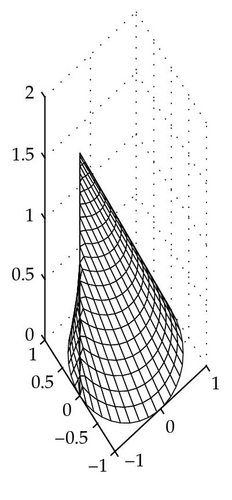
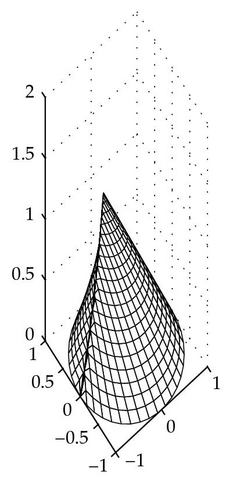
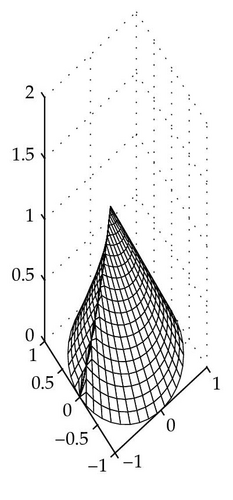
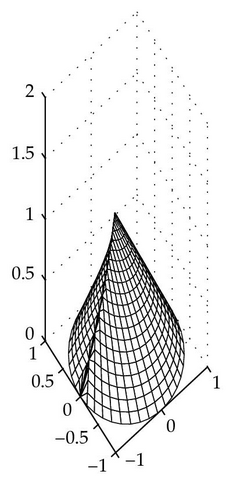
The next theorem, which is the evident consequence of Theorems 4.1 and 5.1, will establish the asymptotic stability criterion in the form of inequalities for matrix equation (1.1).
Theorem 5.4. Let A, B, S ∈ ℝm×m and S−1AS = AT and S−1BS = BT, where AT, BT are the lower triangular matrices with elements λjs, μjs (1 ⩽ j, s ⩽ m), respectively. Let
- (1)
If ρ1j < 1 − ρ2j, then j ∈ AS.
- (2)
If 1 − ρ2j ⩽ ρ1j < min(1 + ρ2j, k/(k − 1)), then for j ∈ AS it is necessary and sufficient to fulfill simultaneously the following conditions ((H1j)), ((H2j)):
( ( H 1 j ) )where ω1j ∈ [0, π/k] is the root of the equation( ( H 2 j ) ) - (3)
If ρ1j⩾min (1 + ρ2j, k/(k − 1)), then j ∉ AS.
6. Examples of the Stability Oval and the Cone for Matrix Equations
Example 6.1. Consider the equation
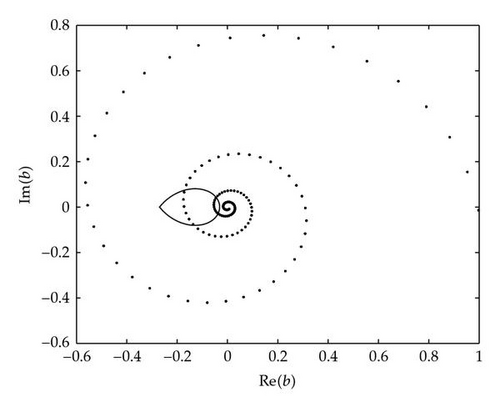
Example 6.2. Consider the equation
Let us find out for what values of s ∈ ℤ+ (6.4) is stable. The eigenvalues of A are λ1,2 = 1.0150exp (±0.0374i). Stability ovals are symmetric about the real axis. Therefore, by Theorem 5.1, only points
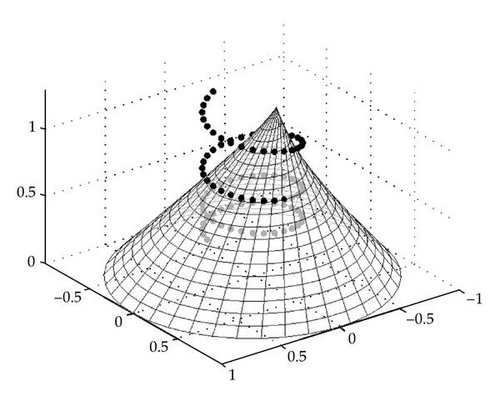
7. Conclusion
The stability analysis for (1.1) in ℝm can be reduced to the pole placement problem for a polynomial of degree km. Our geometric approach allows us to reduce the dimension. To use the approach, we need to know the eigenvalues of A, B. This is the problem of finding the roots of a polynomial of degree m. Using these eigenvalues, we get a finite sequence of points in ℝ3 such that their position with respect to the stability cone allows us to make a conclusion about the stability of (1.1).
In our future work we intend to analyze the stability of equation xn = Axn−m + Bxn−k with two delays m, k with simultaneously triangularizable matrices A, B. The scalar version of this equation was examined in [2, 3, 18]. The stability cone for the matrix differential equation was introduced in [19].
Acknowledgment
The authors are indebted to K. Chudinov, I. Goldsheid, and D. Sheglov for very useful comments.




